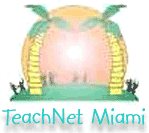

|
How It Works: Weather Watchers is an interactive unit that investigates weather and climate. The purpose is to develop strategies for implementing a student-centered approach through hands-on activities in which reading, writing, science and technology are integrated. Methods include searching web sites to develop task cards for student use, using weather related software, investigating on-line interactive weather sites and communicating between students via e-mail. New media is infused into every aspect of the curriculum from the creation of a student-produced Weather Gazette using desktop publishing, posting weather data on school TV and publishing weather poems and stories on the Internet to comparing results of weather observations with key pals. In the area of language arts, students research various aspects of clouds and rain then write poems and stories. Poem types include shape poems, haiku, acrostic, Cinquain and four-line poetry. Stories can reflect creative writing ideas and weather prompts. The poems and stories are edited and posted on the Kid Authors web site http://kidauthors.com/ Student articles submitted for the Weather Gazette are comprised of weather reports, eye witness news reports of weather happenings, weather jokes, and weather poems. Student teams plan, edit and publish the Weather Gazette; teams can act as reporters, editors, graphics, typists and layout designers. In the area of science, students investigate and collect data from weather web sites, make daily weather observations using weather station equipment and conduct weather experiments using thermometers, barometers and rain gauges. The National Weather Service Page provides weather data, forecasts, current weather conditions and interactive weather information http://nws.noaa.gov . The GLOBE Program web site provides earth science resources, a virtual science museum and weather animations http://globe.gov In the Mad Scientist Network http://madsci.org/ , students can access the Ask-A-Scientist section for weather related questions and answers. Finally, students share results of weather experiments with key pals. Standards: The student uses the reading process effectively. The student uses the writing processes effectively. The student recognizes that processes in the atmosphere interact to shape the Earth. The student uses technology to locate, evaluate and collect information from a variety of sources. The student uses telecommunications to collaborate, publish and interact with peers, experts and other audiences. The student uses technology tools to enhance learning, increase productivity and promote creativity. Estimated Class Periods To Complete: 18 Software Materials Used: Software needed to complete multimedia presentations includes HyperStudio, PowerPoint or Kid Pix. Word processing and desktop publishing can be completed usingMicrosoft Word, The Student Writing Center, ClarisWorks/AppleWorks, or any other writing software. Earth Science activities can be completed using Everything Weather or another weather-related software. Students should have access to the Internet and email for research, online inquiry and communication with key pals. Students: Student population suitable for this project includes students in grades three through six. Average, gifted and exceptional education students will benefit from project activities. Students need to have basic skills in reading, writing and clicking the mouse. The only prerequisites are an interest in learning and curiosity. Students can work individually or in small and large groups as guided by the format of the activities. Overall: Tips: Use http://miamisci.org/hurricane/weathertools.html to learn how to build inexpensive weather tools and how to formulate weather forecasts. When creating task cards, double check all links and steps. Find a great web site and create questions and activities on task cards to correlate with information on pages. Create overhead transparencies of lessons as a back up for unforeseen technical problems. The Interactive Weather Information Network provides information on world weather and weather warnings, weather videos and links to related sites http://iwin.nws.noaa.gov/iwin/graphicsversion/main.html. |
About the Teacher:
Jennifer Williams has worked for Miami-Dade County Public Schools as an Educational Specialist of Curriculum, Gifted, Kindergarten and Music teacher. She has been awarded numerous grants and was the 1998 FACE (Florida Association of Computers in Education) Elementary Technology Teacher of the Year and the 1998 Pine Lake Elementary School Teacher of the Year. Subjects: English, Science Grade Levels: 3-6
|
What do you think of my
project? I'd really like to hear your opinion -
Click here for a very brief survey.